clutch TOYOTA TACOMA 2010 Owners Manual (in English)
[x] Cancel search | Manufacturer: TOYOTA, Model Year: 2010, Model line: TACOMA, Model: TOYOTA TACOMA 2010Pages: 532, PDF Size: 15.03 MB
Page 3 of 532

1
2
3
4
5
6
7
3
2-4. Using other driving systems
Cruise control ...................... 170
Rear view monitor system
(vehicles with auto
anti-glare inside rear
view mirror) ....................... 173
Four-wheel drive system ..... 177
Active traction control
system .............................. 181
AUTO LSD system.............. 183
Rear differential lock
system .............................. 185
Downhill Assist Control
system .............................. 188
Clutch start cancel switch ... 190
Driving assist systems ........ 191
2-5. Driving information
Off-road precautions
(4WD models and
PreRunner) ....................... 197
Cargo and luggage ............. 202
Vehicle load limits ............... 207
Winter driving tips ............... 209
Trailer towing ...................... 213
Dinghy towing ..................... 226
3-1. Using the air conditioning
system and defogger
Air conditioning system ....... 2283-2. Using the audio system
Audio system types ............ 236
Using the radio ................... 239
Using the CD player ........... 245
Playing back MP3 and
WMA discs ....................... 251
Optimal use of the audio
system .............................. 259
Operating the sub woofer
(on some Access Cab
models) ............................ 262
Using the AUX adapter....... 263
Using the steering wheel
audio switches.................. 265
3-3. Using the hands-free phone
system (for cellular phone)
Hands-free phone system
(for cellular phone) ........... 268
Using the hands-free
phone system ................... 272
Making a phone call ........... 280
Setting a cellular phone ...... 285
Security and system
setup ................................ 290
Using the phone book ........ 293
3-4. Using the interior lights
Interior lights list ................. 300
• Interior light ...................... 301
• Personal lights.................. 301
3Interior and exterior
features
Page 22 of 532
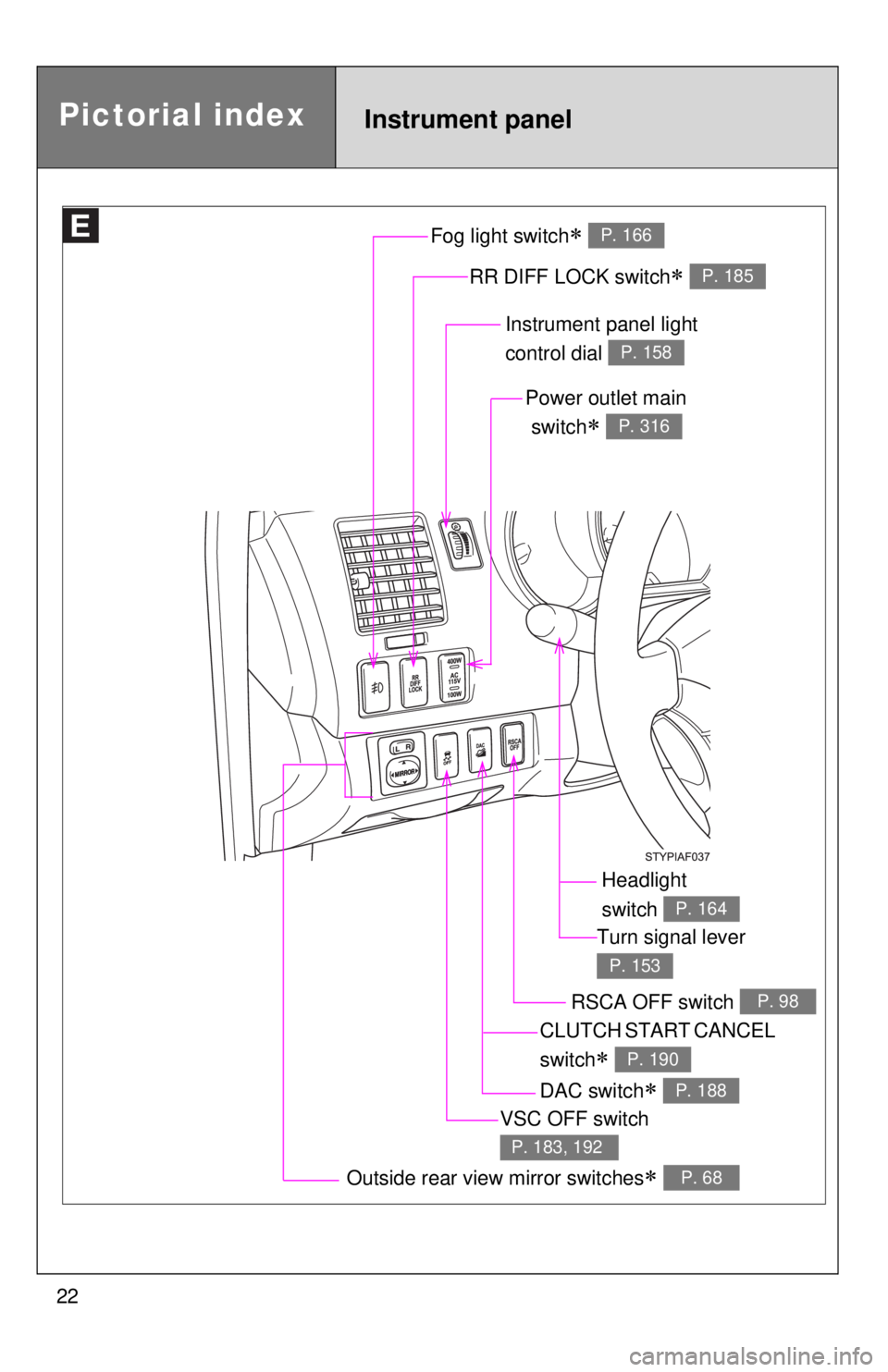
22
Instrument panel light
control dial
P. 158
Outside rear view mirror switches P. 68
RSCA OFF switch P. 98
Fog light switch P. 166
RR DIFF LOCK switch P. 185
Power outlet main
switch
P. 316
Headlight
switch
P. 164
Turn signal lever
P. 153
DAC switch P. 188
VSC OFF switch
P. 183, 192
Pictorial indexInstrument panel
CLUTCH START CANCEL
switch
P. 190
Page 133 of 532
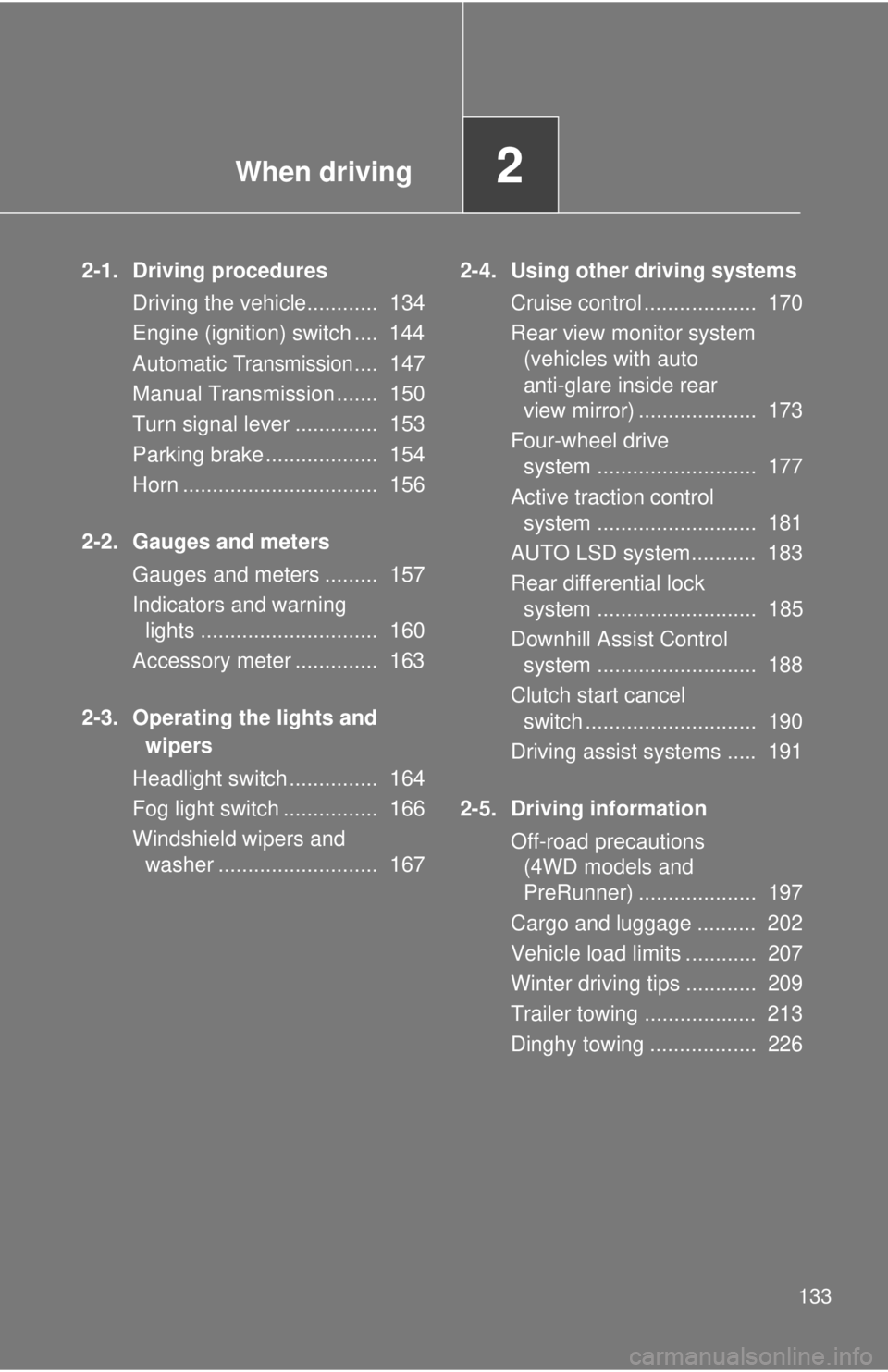
When driving2
133
2-1. Driving procedures
Driving the vehicle............ 134
Engine (ignition) switch .... 144
Automatic
Transmission.... 147
Manual Transmission ....... 150
Turn signal lever .............. 153
Parking brake ................... 154
Horn ................................. 156
2-2. Gauges and meters
Gauges and meters ......... 157
Indicators and warning
lights .............................. 160
Accessory meter .............. 163
2-3. Operating the lights and
wipers
Headlight switch ............... 164
Fog light switch ................ 166
Windshield wipers and
washer ........................... 1672-4. Using other driving systems
Cruise control ................... 170
Rear view monitor system
(vehicles with auto
anti-glare inside rear
view mirror) .................... 173
Four-wheel drive
system ........................... 177
Active traction control
system ........................... 181
AUTO LSD system........... 183
Rear differential lock
system ........................... 185
Downhill Assist Control
system ........................... 188
Clutch start cancel
switch ............................. 190
Driving assist systems ..... 191
2-5. Driving information
Off-road precautions
(4WD models and
PreRunner) .................... 197
Cargo and luggage .......... 202
Vehicle load limits ............ 207
Winter driving tips ............ 209
Trailer towing ................... 213
Dinghy towing .................. 226
Page 134 of 532
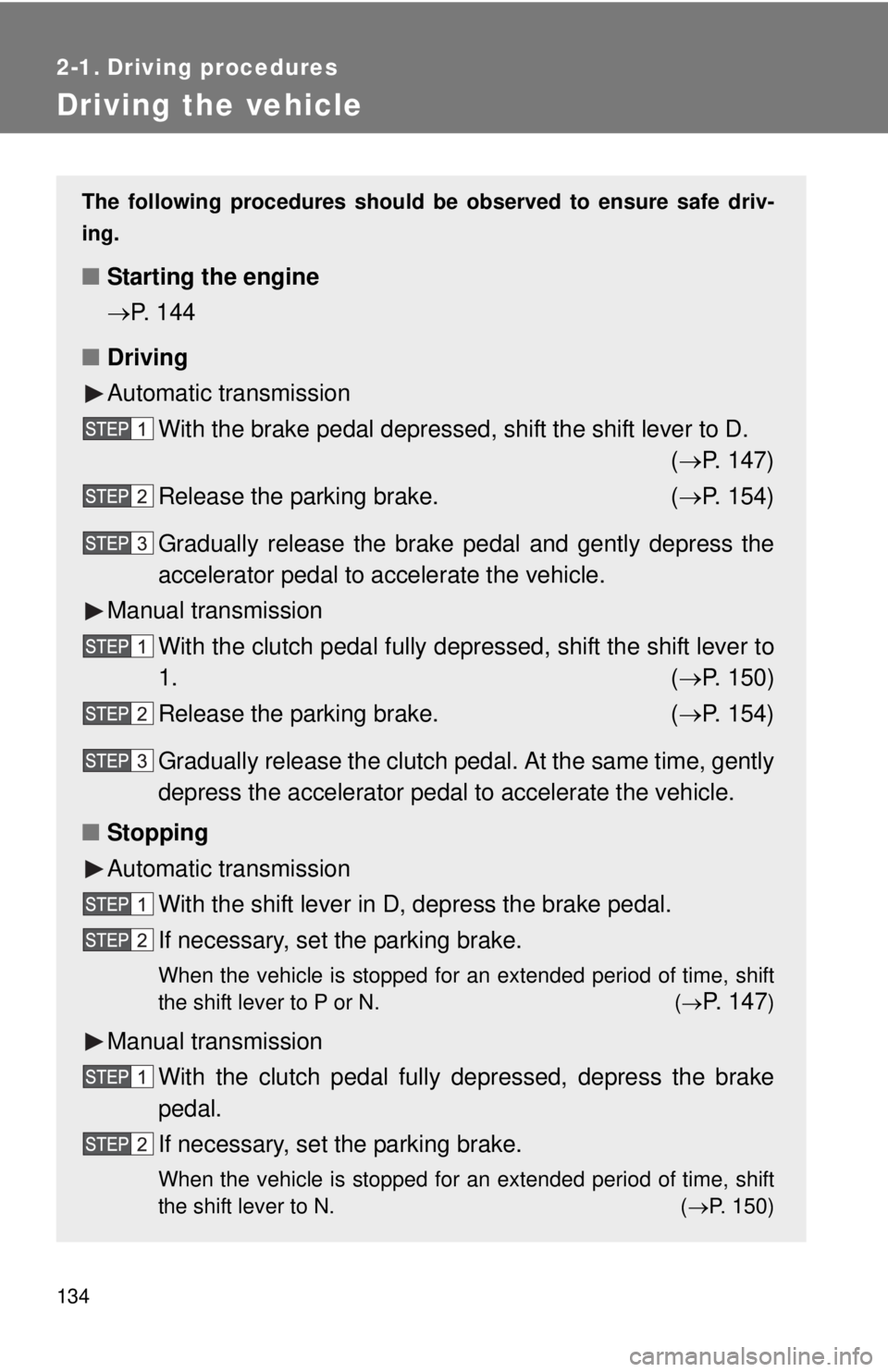
134
2-1. Driving procedures
Driving the vehicle
The following procedures should be observed to ensure safe driv-
ing.
■Starting the engine
P. 144
■Driving
Automatic transmission
With the brake pedal depressed, shift the shift lever to D.
(P. 147)
Release the parking brake. (P. 154)
Gradually release the brake pedal and gently depress the
accelerator pedal to accelerate the vehicle.
Manual transmission
With the clutch pedal fully depressed, shift the shift lever to
1. (P. 150)
Release the parking brake. (P. 154)
Gradually release the clutch pedal. At the same time, gently
depress the accelerator pedal to accelerate the vehicle.
■Stopping
Automatic transmission
With the shift lever in D, depress the brake pedal.
If necessary, set the parking brake.
When the vehicle is stopped for an extended period of time, shift
the shift lever to P or N. (
P. 1 4 7)
Manual transmission
With the clutch pedal fully depressed, depress the brake
pedal.
If necessary, set the parking brake.
When the vehicle is stopped for an extended period of time, shift
the shift lever to N. (P. 150)
Page 135 of 532
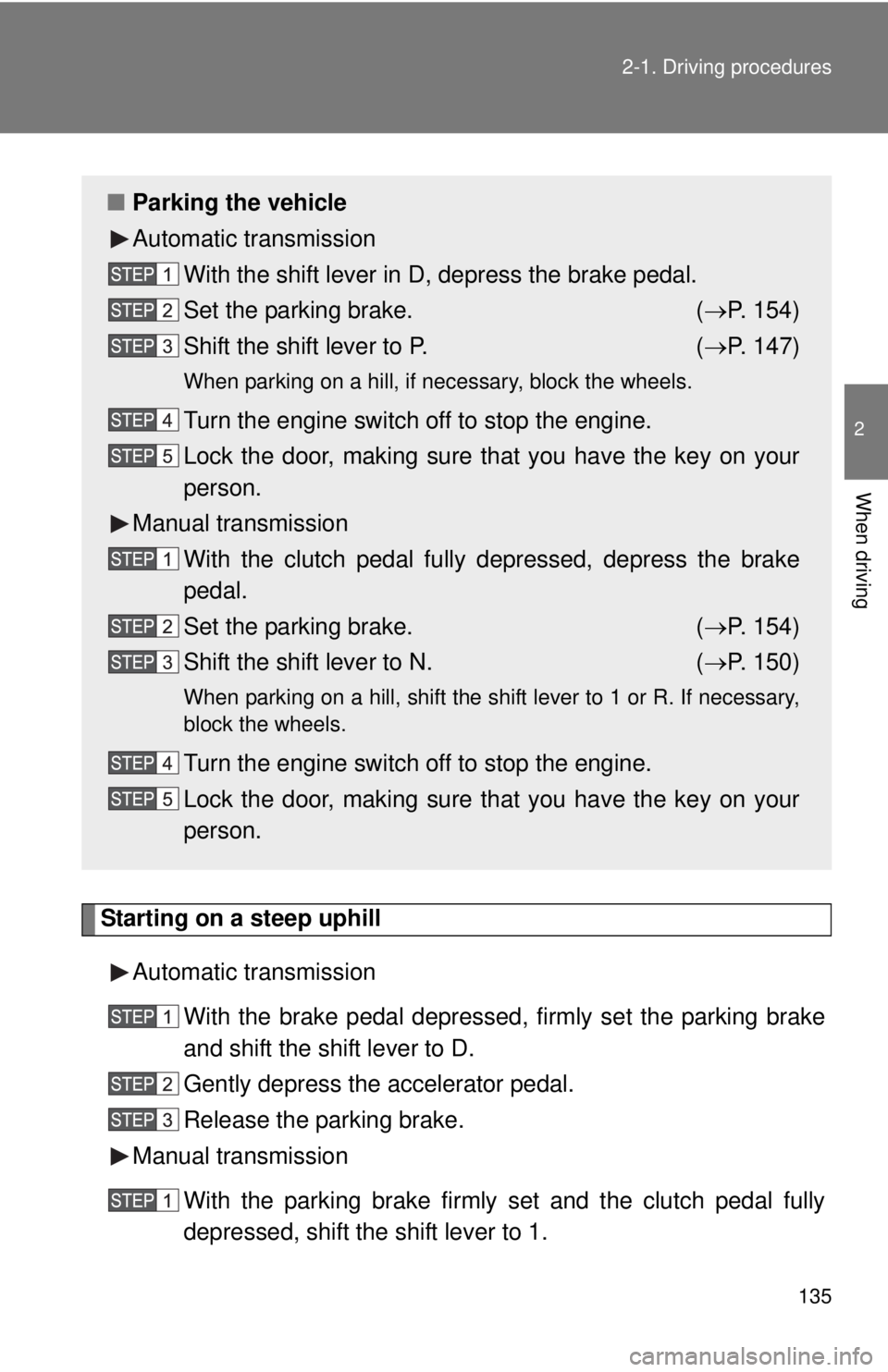
135 2-1. Driving procedures
2
When driving
Starting on a steep uphill
Automatic transmission
With the brake pedal depressed, firmly set the parking brake
and shift the shift lever to D.
Gently depress the accelerator pedal.
Release the parking brake.
Manual transmission
With the parking brake firmly set and the clutch pedal fully
depressed, shift the shift lever to 1.
■Parking the vehicle
Automatic transmission
With the shift lever in D, depress the brake pedal.
Set the parking brake. (P. 154)
Shift the shift lever to P. (P. 147)
When parking on a hill, if necessary, block the wheels.
Turn the engine switch off to stop the engine.
Lock the door, making sure that you have the key on your
person.
Manual transmission
With the clutch pedal fully depressed, depress the brake
pedal.
Set the parking brake. (P. 154)
Shift the shift lever to N. (P. 150)
When parking on a hill, shift the shift lever to 1 or R. If necessary,
block the wheels.
Turn the engine switch off to stop the engine.
Lock the door, making sure that you have the key on your
person.
Page 136 of 532
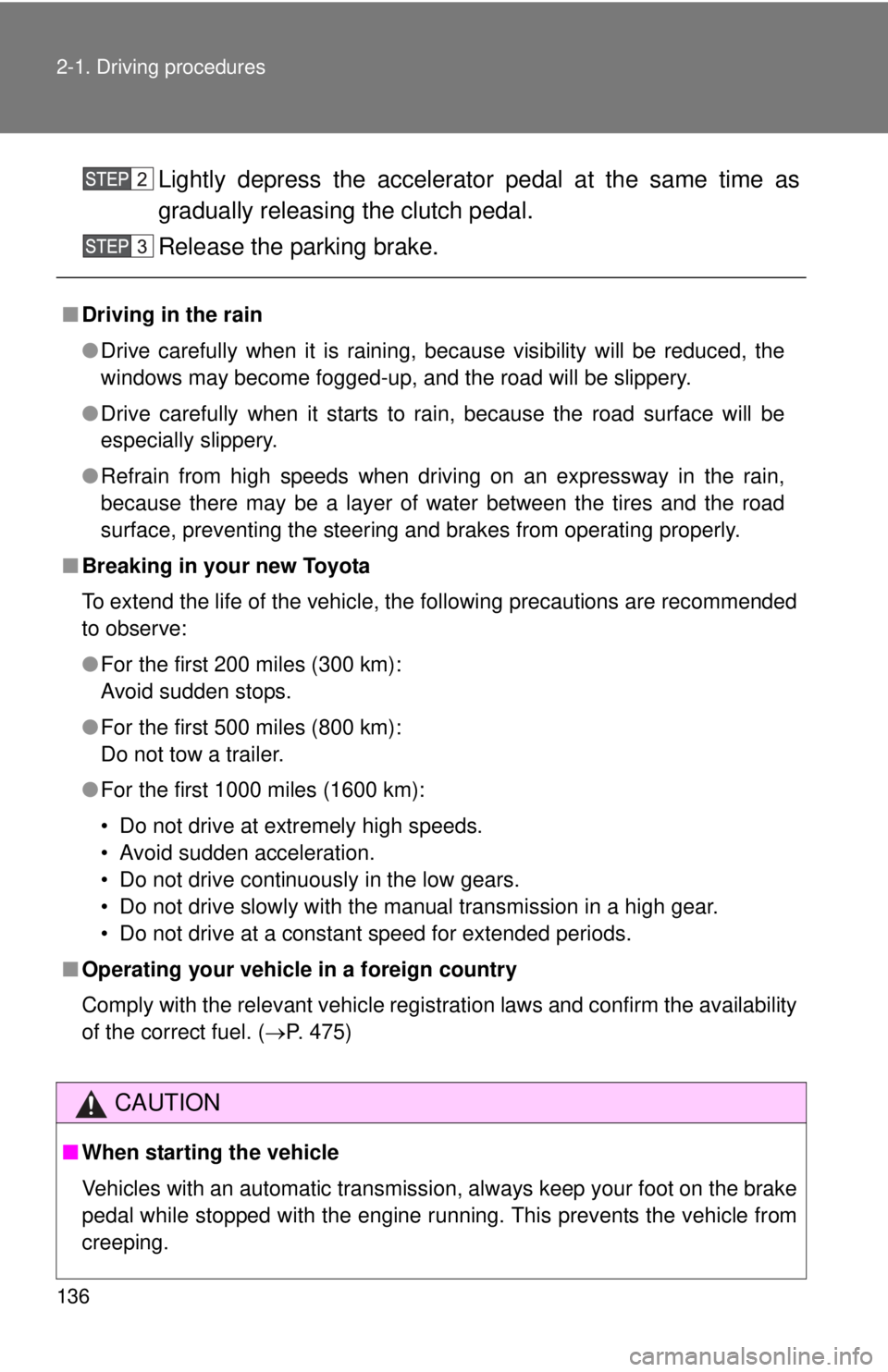
136 2-1. Driving procedures
Lightly depress the accelerator pedal at the same time as
gradually releasing the clutch pedal.
Release the parking brake.
■Driving in the rain
●Drive carefully when it is raining, because visibility will be reduced, the
windows may become fogged-up, and the road will be slippery.
●Drive carefully when it starts to rain, because the road surface will be
especially slippery.
●Refrain from high speeds when driving on an expressway in the rain,
because there may be a layer of water between the tires and the road
surface, preventing the steering and brakes from operating properly.
■Breaking in your new Toyota
To extend the life of the vehicle, the following precautions are recommended
to observe:
●For the first 200 miles (300 km):
Avoid sudden stops.
●For the first 500 miles (800 km):
Do not tow a trailer.
●For the first 1000 miles (1600 km):
• Do not drive at extremely high speeds.
• Avoid sudden acceleration.
• Do not drive continuously in the low gears.
• Do not drive slowly with the manual transmission in a high gear.
• Do not drive at a constant speed for extended periods.
■Operating your vehicle in a foreign country
Comply with the relevant vehicle registration laws and confirm the availability
of the correct fuel. (P. 475)
CAUTION
■When starting the vehicle
Vehicles with an automatic transmission, always keep your foot on the brake
pedal while stopped with the engine running. This prevents the vehicle from
creeping.
Page 142 of 532

142 2-1. Driving procedures
CAUTION
●The brake system consists of 2 individual hydraulic systems: If one of the
systems fails, the other will still operate. In this case, the brake pedal
should be depressed more firmly than usual and braking distance
becomes longer.
Do not drive your vehicle with only a single brake system. Have your
brakes fixed immediately.
NOTICE
■When driving the vehicle
Vehicles with a manual transmission
●Do not rest your foot on the clutch pedal while driving.
Doing so may cause clutch trouble.
●Do not use any gears other than the first gear when starting off and mov-
ing forward.
Doing so may damage the clutch.
●Do not use the clutch to hold the vehicle when stopping on an uphill grade.
Doing so may damage the clutch.
Vehicles with an automatic transmission
●Do not use the accelerator pedal or depress accelerator and brake pedals
together to hold the vehicle on a hill.
■When parking the vehicle
Vehicles with an automatic transmission: Always put the shift lever in P.
Failure to do so may cause the vehicle to move or the vehicle may acceler-
ate suddenly if the accelerator pedal is accidentally depressed.
■Avoiding damage to vehicle parts
●Do not turn the steering wheel fully in either direction and hold it there for a
long time.
Doing so may damage the power steering pump.
●When driving over bumps in the road, drive as slowly as possible to avoid
damaging the wheels, underside of the vehicle, etc.
Page 144 of 532
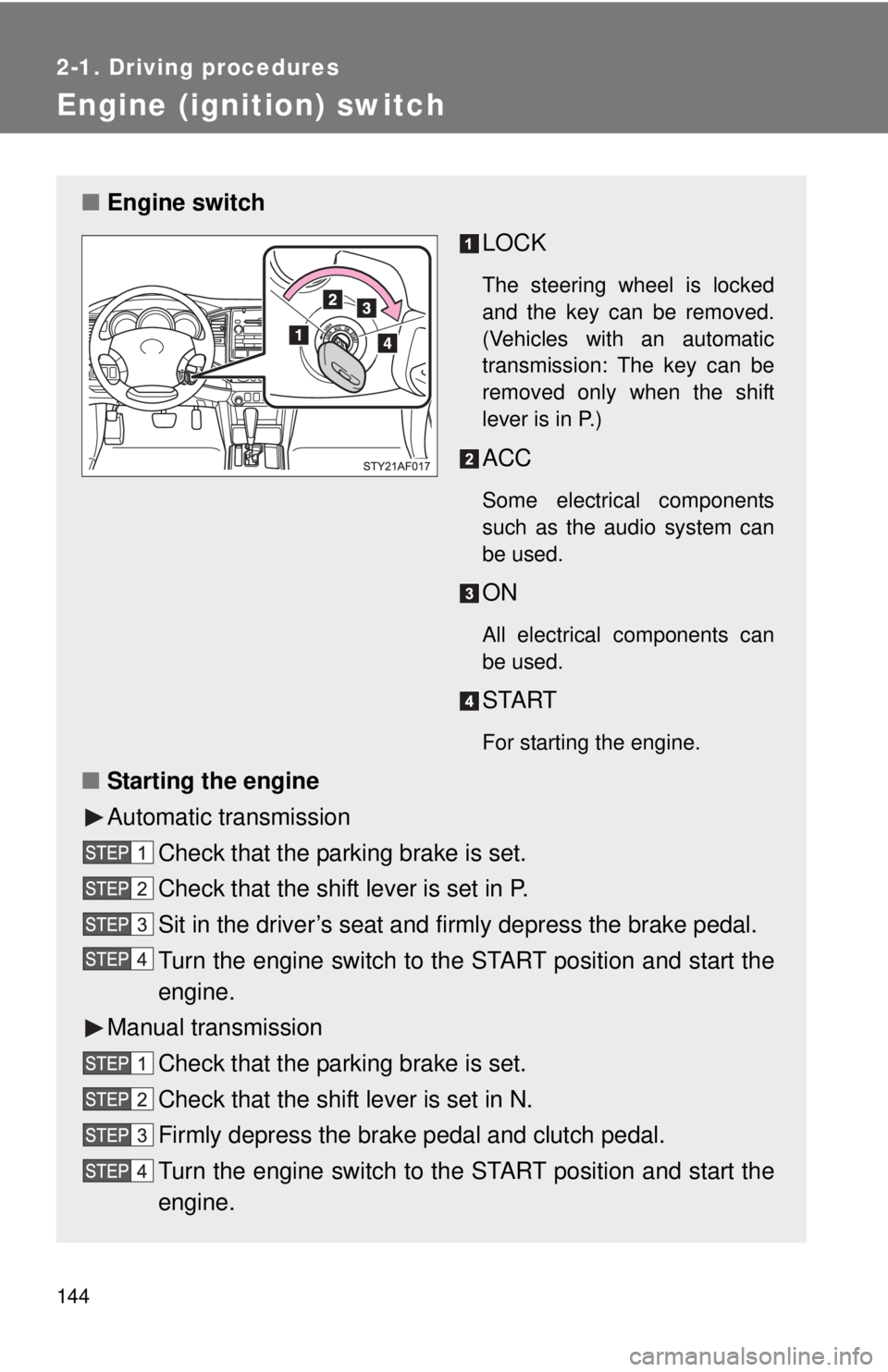
144
2-1. Driving procedures
Engine (ignition) switch
■Engine switch
LOCK
The steering wheel is locked
and the key can be removed.
(Vehicles with an automatic
transmission: The key can be
removed only when the shift
lever is in P.)
ACC
Some electrical components
such as the audio system can
be used.
ON
All electrical components can
be used.
START
For starting the engine.
■Starting the engine
Automatic transmission
Check that the parking brake is set.
Check that the shift lever is set in P.
Sit in the driver’s seat and firmly depress the brake pedal.
Turn the engine switch to the START position and start the
engine.
Manual transmission
Check that the parking brake is set.
Check that the shift lever is set in N.
Firmly depress the brake pedal and clutch pedal.
Turn the engine switch to the START position and start the
engine.
Page 150 of 532
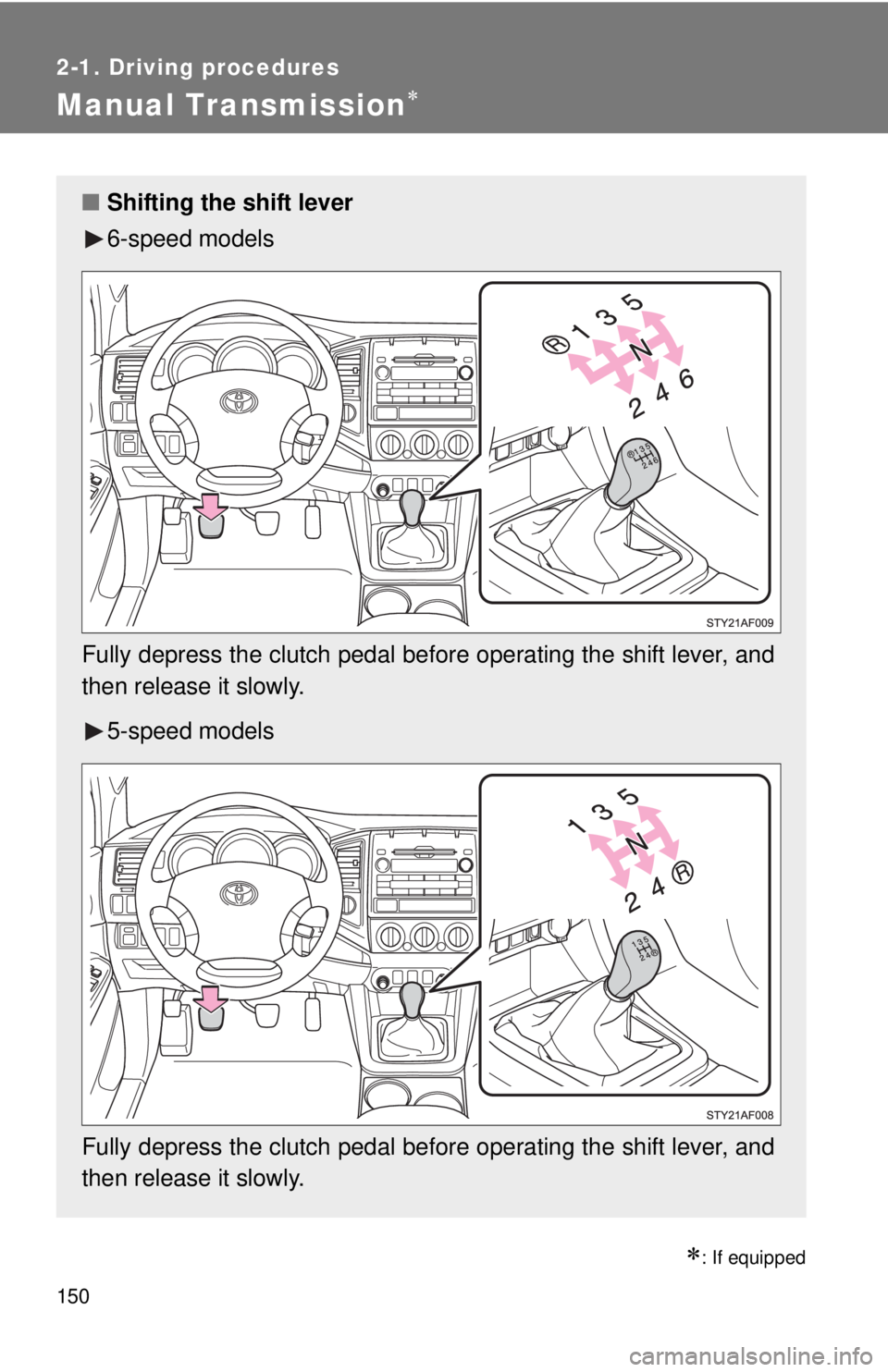
150
2-1. Driving procedures
Manual Transmission
: If equipped
■Shifting the shift lever
6-speed models
Fully depress the clutch pedal before operating the shift lever, and
then release it slowly.
5-speed models
Fully depress the clutch pedal before operating the shift lever, and
then release it slowly.
Page 171 of 532
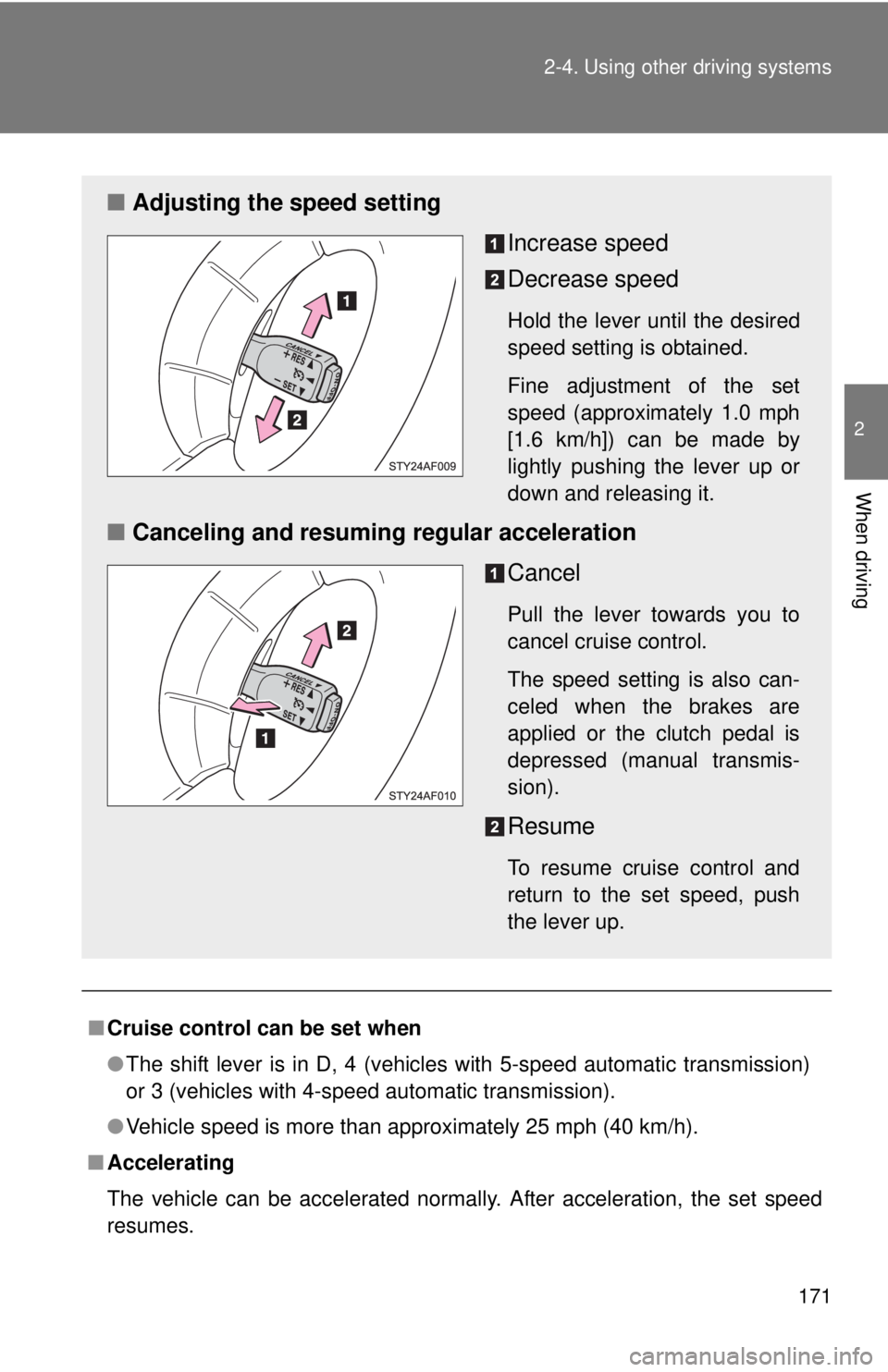
171 2-4. Using other driving systems
2
When driving
■Cruise control can be set when
●The shift lever is in D, 4 (vehicles with 5-speed automatic transmission)
or 3 (vehicles with 4-speed automatic transmission).
●Vehicle speed is more than approximately 25 mph (40 km/h).
■Accelerating
The vehicle can be accelerated normally. After acceleration, the set speed
resumes.
■Adjusting the speed setting
Increase speed
Decrease speed
Hold the lever until the desired
speed setting is obtained.
Fine adjustment of the set
speed (approximately 1.0 mph
[1.6 km/h]) can be made by
lightly pushing the lever up or
down and releasing it.
■Canceling and resuming regular acceleration
Cancel
Pull the lever towards you to
cancel cruise control.
The speed setting is also can-
celed when the brakes are
applied or the clutch pedal is
depressed (manual transmis-
sion).
Resume
To resume cruise control and
return to the set speed, push
the lever up.